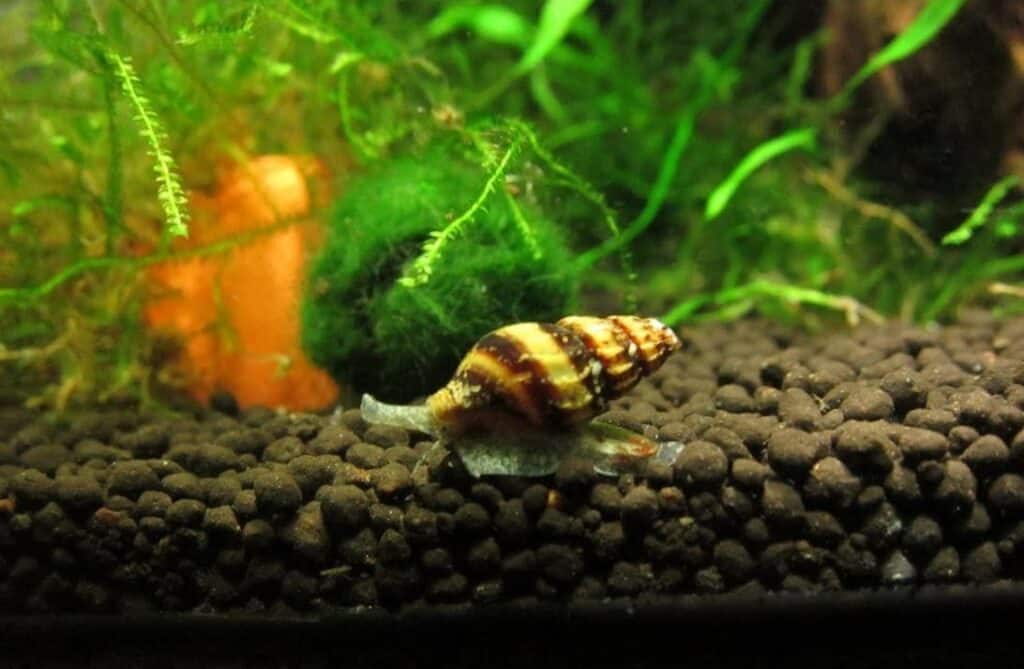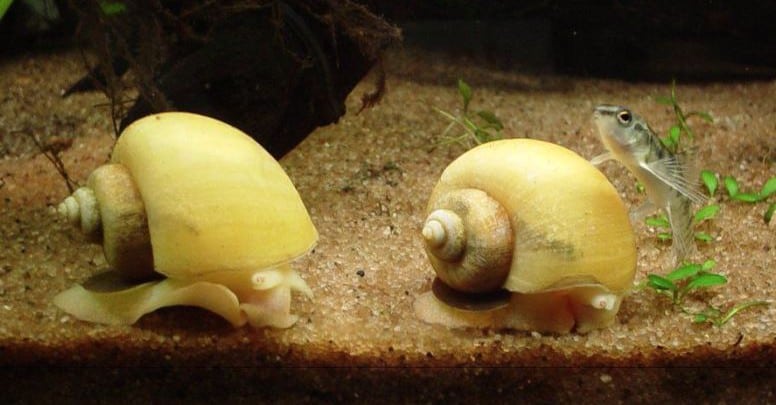In this article Show
If you’re anything like me, each member of your aquarium, from the tiniest snail to the most flamboyant fish, holds a special place in your heart. We want what’s best for them, and that includes ensuring any treatments or additives we use won’t unintentionally harm any of our underwater friends.
Enter Melafix, a popular treatment for various fish ailments. But as many of us have pondered – is it safe for every dweller in our tanks, especially the gentle snails that glide so peacefully along the glass and substrate?
Yes, Melafix is generally considered safe for snails in most aquarium settings. However, aquarists should always administer it with caution, ensuring the correct dosage and closely monitoring their snails’ behavior.
I’ve dived deep into this question, considering both my personal experiences and the insights of the broader aquarium community. So, let’s embark on this journey together and find out whether Melafix and our beloved snails can coexist in harmony.

What Is Melafix?
Melafix is an all-natural treatment used in freshwater aquariums to heal fish infections and repair damaged fins, ulcers, and open wounds. It’s a product derived primarily from tea tree oil, which is known for its antiseptic properties.
Melafix can promote the regrowth of damaged fish tissue, making it a popular choice among aquarists for treating a variety of conditions.
The treatment is designed to be safe for the entire aquatic environment, including plants, but it’s always recommended that users ensure the correct dosage and monitor the reactions of all tank inhabitants when introducing any new treatment.
The Crucial Role of Snails in Aquariums
Snails are more than just slow-moving creatures that add a touch of intrigue to your aquarium; they play several essential roles that contribute to the health and balance of a tank ecosystem. Here’s why snails are indispensable:
1. Natural Cleaners
Snails are efficient scavengers, consuming algae, detritus, and leftover food. This helps keep the tank clean, reducing the need for frequent maintenance, and preventing unsightly algae blooms.
2. Biofilm Management
Biofilm, a slimy layer formed by bacteria on surfaces, can accumulate in aquariums. Snails naturally graze on this, maintaining a healthy balance of beneficial bacteria while ensuring the tank surfaces remain clear.
3. Substrate Aeration
Certain snail species burrow into the substrate, which aids in aerating the bottom layers of the tank. This is vital for the roots of aquatic plants and beneficial for the microorganisms that reside in the substrate.
4. Indicator of Water Quality
Snails can act as bio-indicators. Their behavior or health can give aquarists early warnings about potential problems with water quality, enabling timely interventions.
5. Natural Food Source
In ecosystems where snail populations might explode due to favorable conditions, they can serve as a food source for certain fish species, contributing to the food chain.
6. Aesthetic Appeal
Beyond their functional benefits, snails introduce a unique form of movement and interaction in the tank. Their graceful, slow-paced glide can be meditative to watch, adding another layer of enjoyment to the aquarium hobby.
Effects of Melafix on Snails
The question of how Melafix impacts snails is one that has spurred numerous discussions among aquarists.
Given that Melafix is primarily designed for fish treatment, its interaction with other tank inhabitants, particularly snails, is crucial to understand. Here’s what is known so far:
1. General Safety
For the most part, Melafix is deemed safe for snails when used at the recommended dosage. Its primary ingredient, tea tree oil, doesn’t inherently pose a threat to snails.
2. Anecdotal Observations
Some aquarists have reported observing no adverse effects on their snails’ post-Melafix treatment, while a few others have noted decreased activity or even retreat into shells.
However, these isolated incidents might not necessarily be attributed solely to Melafix and could be a result of other factors like water quality or stress.
3. Potential for Overdosage
As with any treatment, there’s a potential risk if Melafix is used in quantities exceeding the recommended dosage. Overdosing could stress or harm all tank inhabitants, including snails.
4. Behavioral Monitoring
Post-treatment, it’s advised to observe snails closely. Any abrupt change in behavior, like reduced movement, prolonged hiding, or not sticking to surfaces, might indicate distress. Although not necessarily a direct effect of Melafix, it’s crucial to monitor and address any such changes.

5. Interaction with Other Treatments
While Melafix alone might be safe for snails, combining it with other treatments or medications could produce unforeseen reactions. It’s always best to introduce one treatment at a time and observe its effects.
6. Lack of Comprehensive Studies
As of my last update, there haven’t been extensive scientific studies exclusively focused on the impact of Melafix on snails. Most of the information comes from experiential accounts of aquarists.
Possible Reasons for Adverse Reactions
Whenever an adverse reaction occurs in an aquarium, it’s a sign that something is amiss. Determining the root cause can be challenging, given the myriad of factors at play. In the context of using treatments like Melafix and observing negative responses, here are some possible reasons:
1. Overdosage
One of the most common causes of adverse reactions is using a treatment in quantities higher than the recommended dose. Even products deemed safe can become problematic when administered excessively.
2. Interaction with Other Chemicals
Combining Melafix with other treatments, medications, or even certain water conditioners can lead to unexpected chemical interactions, which might not be suitable for all tank inhabitants.
3. Sensitivity Among Species
While many snails might tolerate Melafix, specific species or individual snails could be more sensitive to its ingredients. Just like how some fish species are more delicate than others, the same applies to snails.
4. Pre-existing Stress
If snails or other tank inhabitants were already stressed due to factors like abrupt changes in water parameters, the introduction of new tank mates, or any other disturbances, adding a treatment might exacerbate the stress.
5. Water Quality Issues
An adverse reaction might not be directly due to the treatment but could be amplified by underlying water quality issues. Factors like imbalanced pH, high ammonia or nitrite levels, and fluctuating temperatures can make inhabitants more vulnerable.
6. Incomplete Acclimatization
Especially when introducing new snails or fish to a tank that’s recently been treated, failing to properly acclimate them can lead to adverse reactions. The abrupt change in environment, combined with the presence of treatment residues, can be overwhelming.
7. Expired or Contaminated Product
Using an expired or, worse, contaminated bottle of Melafix or any other treatment can have unforeseen adverse effects. Always ensure the product is within its use-by date and stored correctly.
8. Inaccurate Diagnosis
At times, aquarists might misdiagnose a problem and administer treatments that aren’t necessary, leading to undue stress or adverse reactions in the aquatic environment.

Tips For Safe Use of Melafix In Snail-Inhabited Aquariums
Using Melafix in a snail-inhabited aquarium requires attention to detail and a gentle touch. Here are some tips to ensure the safety of your snails and other tank inhabitants:
- Always stick to the manufacturer’s guidelines. More doesn’t mean better. Overdosing can lead to unnecessary complications, not just for snails but for other tank residents as well.
- Instead of adding the full dose of Melafix at once, consider introducing it slowly over a few hours. This gradual addition can help acclimatize the inhabitants to the treatment.
- Pay close attention to your snails after adding Melafix. Look for signs of distress or changes in behavior, like reduced movement, retreating into shells, or detachment from surfaces.
- Increasing aeration during and after treatment can ensure sufficient oxygen levels, which is vital when introducing any new substance to the aquarium.
- If you’re treating specific fish, consider moving them to a quarantine or hospital tank. This way, you can administer Melafix without exposing the entire tank, and especially the snails, to the treatment.
- Unless you’re certain about the compatibility of different treatments, avoid mixing Melafix with other medications or chemicals. Combining treatments can lead to unforeseen reactions.
- Conduct regular water quality tests to monitor parameters like pH, ammonia, nitrites, and nitrates. Ensuring stable water conditions can reduce the chances of adverse reactions when introducing treatments.
Alternative Remedies and Solutions
When looking for alternatives to Melafix, especially in a snail-inhabited aquarium, it’s important to opt for solutions that are both effective for the specific issue at hand and safe for all tank inhabitants. Here are some alternatives to consider:
1. Pimafix
Made by the same company as Melafix, Pimafix is an all-natural antifungal remedy derived from the West Indian Bay Tree. It’s designed to treat fungal infections in fish and is generally safe for snails and other tank residents.
2. Salt Baths
A salt bath using aquarium salt can help address a variety of fish ailments, including some external parasites and minor fungal infections. Always ensure you’re using the correct salt concentration and that the duration is appropriate for the specific issue you’re addressing.
3. Epsom Salt
Not to be confused with regular aquarium salt, Epsom salt can help with issues related to bloating and swelling. It’s a gentle solution but ensure it doesn’t negatively impact snails or plants.
4. Indian Almond Leaves
These leaves, when added to an aquarium, release tannins that have natural antibacterial and antifungal properties. They can help create a more natural environment and boost fish immunity.
5. Garlic
Garlic extract or freshly crushed garlic can be used as a natural remedy against internal and external parasites. It can also act as an appetite stimulant for fish.
6. UV Sterilizers
These devices can help in eliminating pathogens from the water. They’re effective against certain parasites and bacteria, ensuring cleaner water without the addition of chemicals.
7. Quarantine Tanks
Before resorting to treatments, consider using a quarantine or hospital tank. Isolating sick fish can prevent the spread of disease and allows for targeted treatment without affecting the main tank.
Conclusion
Navigating the world of aquarium care requires diligence, knowledge, and a touch of intuition. While products like Melafix offer solutions for specific issues, it’s imperative to consider the broader health and well-being of every tank inhabitant.
By staying informed, observing our aquatic friends closely, and exploring various remedies when needed, we can ensure a thriving, harmonious environment for all.
Whether you’re a seasoned aquarist or a newbie, remember that every decision made impacts a delicate ecosystem, so tread with care and passion.






